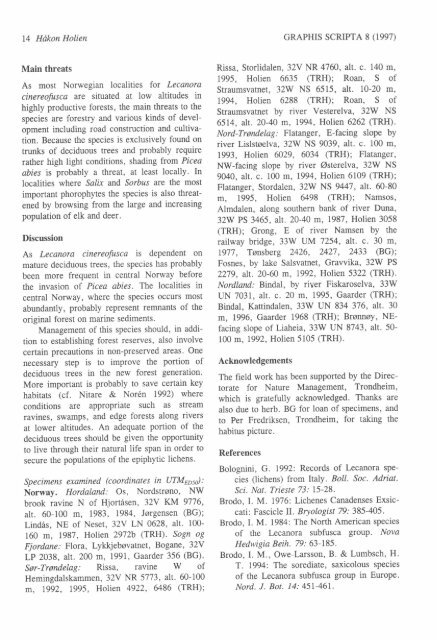GMPHIS SCRIPTA - Universitetet i Oslo
GMPHIS SCRIPTA - Universitetet i Oslo
GMPHIS SCRIPTA - Universitetet i Oslo
Create successful ePaper yourself
Turn your PDF publications into a flip-book with our unique Google optimized e-Paper software.
14 Hdkon Holien<br />
Main threats<br />
As most Norwegian localities for Lecanora<br />
cinereofusca are siruated at low altitudes in<br />
highly productive forests, the main threats to the<br />
species are forestry and various kinds of development<br />
including road construction and cultivation.<br />
Because the species is exclusively found on<br />
trunks of deciduous trees and probably require<br />
rather high light conditions, shading from Picea<br />
abies is probably a threat, at least locally- In<br />
localities where Salix and Sorbus ate the most<br />
important phorophytes the species is also threatened<br />
by browsing from the large and increasing<br />
population of elk and deer.<br />
Discussion<br />
As Lecanora cinereofusca is dependent on<br />
mature deciduous trees, the species has probably<br />
been more frequent in central Norway before<br />
the invasion of Picea abies. The localities in<br />
central Norway, where the species occurs most<br />
abundantly, probably represent remnants of the<br />
original forest on marine sediments.<br />
Management of this species should, in addition<br />
to establishing forest reserves, also involve<br />
certain precautions in non-preserved areas. One<br />
necessary step is to improve the portion of<br />
deciduous trees in the new forest generation.<br />
More important is probably to save certain key<br />
habitats (cf. Nitare & Nor6n 1992) where<br />
conditions ate appropriate such as stream<br />
ravines, swamps, and edge forests along rivers<br />
at lower altitudes. An adequate portion of the<br />
deciduous trees should be given the opportunity<br />
to live through their natural life span in order to<br />
secure the populations of the epiphytic lichens.<br />
Specimens examined (coordinates in WMBp5d:<br />
Norway. Hordaland: Os, Nordstrsno, NW<br />
brook ravine N of Hjortisen, 32Y KM 9776,<br />
alt. 60-100 m, 1983 , 1984, Jorgensen (BG);<br />
Lindis, NE of Neset, 32V LN 0628, alt. 100-<br />
160 m, 1987, Holien 2972b (TRH) . Sogn og<br />
Fjordane: Flora, Lykkjebovatnet, Bogane, 32V<br />
LP 2038, alt. 200 m, 1991, Gaarder 356 (BG).<br />
Sor-Trsndelag: Rissa, ravine W of<br />
Hemingdalskammen, 32V NR 5773, alt. 60-100<br />
m, L992, 1995, Holien 4922, 6486 (TRH);<br />
GRAPHIS <strong>SCRIPTA</strong> 8 (1997)<br />
Rissa, Storlidalen, 32Y NR 4760, alt. c. 140 m,<br />
1995, Holien 6635 (TRH); Roan, S of<br />
Straumsvatnet, 32W NS 6515, alt. 10-20 m,<br />
1994, Holien 6288 (TRH); Roan, S of<br />
Straumsvatnet by river Vesterelva, 32W NS<br />
6514, alt. 20-40 m, 1994, Holien 6262 (TRH).<br />
Nord-Trsndelag: Flatanger, E-facing slope by<br />
river Lislstselva, 32W NS 9039, alt. c. 100 m,<br />
1993, Holien 6029, 6034 (TRH); Flatanger,<br />
NW-facing slope by river Asterelwa, 32W NS<br />
9040, alt. c. 100 m, 1994, Holien 6109 (TRH);<br />
Flatanger, Stordalen, 32W NS 9447, alt. 60-80<br />
m, L995, Holien 6498 (TRH); Namsos,<br />
Almdalen, along southern bank of river Duna,<br />
32W PS 3465, alt. 20-40 m, 1987, Holien 3058<br />
(TRH); Grong, E of river Namsen bY the<br />
railway bridge, 33W UM 7254, alt. c. 30 m,<br />
1977, Tonsberg 2426, 2427, 2433 (BG);<br />
Fosnes, by lake Salsvatnet, Gravvika, 32W PS<br />
2279, alt. 20-60 m, 1992, Holien 5322 (TRH).<br />
Nordlard.' Bindal, by river Fiskaroselva, 33W<br />
UN 7031, alt. c. 20 m, 1995, Gaarder (TRH);<br />
Bindal, Kattindalen, 33W UN 834 376, alt. 30<br />
m, 1996, Gaarder 1968 (TRH); Brarnoy, NEfacing<br />
slope of Liatreia, 33W UN 8743, alt. 50-<br />
100 m, 1992, Holien 5105 (TRH).<br />
Acknowledgements<br />
The field work has been supported by the Directorate<br />
for Nature Management, Trondheim,<br />
which is gratefully acknowledged. Thanks are<br />
also due to herb. BG for loan of specimens, and<br />
to Per Fredriksen, Trondheim, for taking the<br />
habirus picture.<br />
References<br />
Bolognini, G. 1992: Records of Lecanora species<br />
(lichens) from Italy. BoIl. Soc. Adriat.<br />
Sci. Nat. Trieste 73: L5-28.<br />
Brodo, I. M . 1976: Lichenes Canadenses Exsiccati:<br />
Fascicle II. Bryologist 79: 385-405.<br />
Brodo, I. M. 1984: The North American species<br />
of the Lecanora subfusca group. Nova<br />
Hedwigia Beih. 79: 63-185.<br />
Brodo, I. M., Owe-Larsson, B. & Lumbsch, H.<br />
T. 1994: The sorediate, saxicolous species<br />
of the Lecanora subfusca group in Europe.<br />
Nord. J. Bot. 14: 45t-461.

















